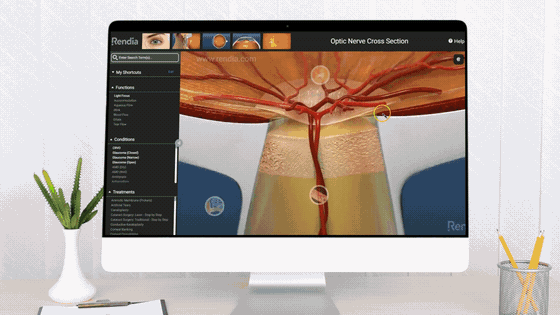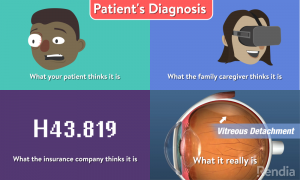Now you can use a vision simulator to show how an eye condition progresses
If you subscribe to Rendia’s newsletter or read announcements through our product’s chat feature, you may have heard about some of our recent product updates. In just the past year, our interactive anatomy tool, Exam Mode, has expanded to include treatment animations, the ability to customize through My Shortcuts, and most recently, an app for the iPad. And that doesn’t even take into account the dozens of bug fixes, additional features, and new videos we’ve also added along the way!
As you might imagine, we’re a busy bunch. The Rendia team is always looking for ways to add value to the platform, and we listen closely to customer suggestions. We heard that you needed the ability to show a patient symptoms of their condition. In response to that feedback, we’ve upgraded Exam Mode to include Point-of-Views.
What’s the point (-of-views)?
Point-of-Views (POVs) are a simulation of vision for a given condition. Thanks to the picture-in-picture layout, POVs let you simultaneously show the anatomy and visual simulation, and demonstrate how these change as the condition progresses over time. POVs, like the rest of Exam Mode, are intended for quick visual references on the fly during your chairside conversations.

Show how eye conditions progress with our new Point-of-Views feature
If your account does not have Exam Mode access, contact us about upgrading.
If you already have access to Exam Mode, then you automatically have access to POVs and can start using them immediately. All you have to do is use the sidebar to select an eye condition, such as Glaucoma (Closed), then click the small POV image on the playbar at the bottom of the screen. For conditions that have an associated POV, the button will automatically appear, but there are some conditions that do not have visual symptoms, and thus, no POV. To close the POV and return to the full anatomy Condition view, just click the anatomy image button in the playbar. Feel free to send us a message at [email protected] if you’d like to schedule a training to walk you through it, and we’ll be in touch.
Like the rest of Rendia, you can draw on the animation to direct patients’ attention to certain areas during your explanation. The POVs feature is even available in the Exam Mode for iPad app.
How POVs combat the “curse of knowledge”
By showing how a condition affects a patient’s vision, you can convey a powerful message. First, you help show how the anatomy relates to their visual outcomes. To a health professional with years of accumulated anatomy and pathophysiology knowledge, certain health concepts may seem simple and obvious. However, if you’ve ever read Made to Stick by Chip and Dan Heath, you may be familiar with the “curse of knowledge” concept. The curse of knowledge means that once you know something, it’s impossible to remember what it’s like to not know it.

Remember that for a lot of your patients, your exam room may be the first time they’re hearing about a condition. For other patients, they might have heard of their diagnosis, but what they’ve been imagining is completely inaccurate or missing a critical detail. What patients picture in their minds when you describe the condition may be far from what’s happening anatomically — and this could make all the difference in their health decisions down the road.
For example, have you ever had a patient skip their regular appointment or neglect their treatment regimen? It’s possible that they didn’t have a complete understanding of the consequences of doing so. By accompanying your explanations with an anatomy visual and tying that back to a simulated image of their vision, patients will achieve that “aha” moment. Because visuals can resonate so powerfully, once a patient sees and understands how neglecting treatments or follow-up appointments could impact their vision, they’ll be highly motivated to stick to your prescription.
Understanding the correlation between the condition and visual outcomes also allows patients to weigh treatment options more effectively.
POVs aren’t only valuable for educating patients. You can use them to show family caregivers and even staff members in your practice what patients are experiencing. By doing so, you’ll build empathy for patients and ensure that everyone on the care team has a strong appreciation for what patients are going through. A simple, yet powerful visual can make all the difference in patient interactions along the care continuum.
What’s next?
Since we’re always working to improve Rendia, we’ll be taking simulated vision to the next level in a future product update. Currently, POVs are only available for customers (or those taking a free trial) of the eye care specialty, but if you have ideas for how we could create a similar tool for the ENT version, we’re all ears! Email us at [email protected].
Be sure to follow us on Twitter or subscribe to our newsletter to stay in the loop for future product updates. If you want to be a beta tester and get a sneak peek of our latest features before the rest of our customers, sign up to user test today.

